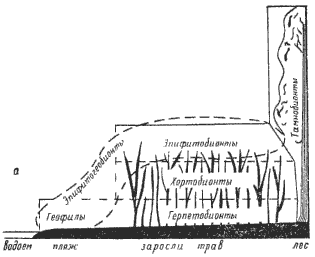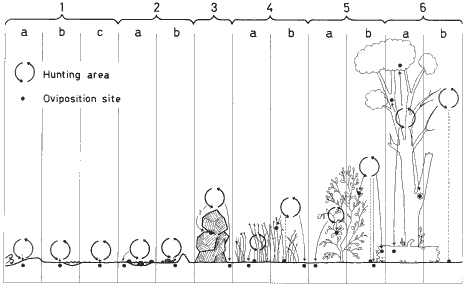|
LONDT (1994): "No attempt has hitherto been made to classify Afrotopical Asilidae with respect to the habits they normally occupy. Although there are a number of publications dealing with the habitat preferences of non-Afrotropical species, few authors have attempted to provide an overview of even a small reginal fauna. The following two exceptions are worthy of mention.
Lehr (1979), using his considerable experience of the Palaearctic fauna, developed interesting thoughts on a system of ecological classification in which he identified six 'trophic complexes', using the prey-capturing strategies of the adult Asilidae involved(Fig. 1). With the additional aid of an unpublished translation of part of Lehr's orginal article, sent to me by the author, the following English summery of his classification may be presented.
| Geophils |
Hunt from surface of bald earth |
| Herpetobions |
Hunt from the surface of the earth but in the grass thicket |
| Chortobions |
Hunt inside the grass thicket |
| Epiphytobions |
Hunt above the grass surface |
| Epiphytogeobions |
Hunt both the surface of the earth and from the grass |
| Tannobions |
Hunt from the trees |

Fig. 1. The 'life forms' of Asilidae as suggested by Lehr (1979).
The other attempt to group Asilidae in ecological categories on the basis of their usual perching positions, was included in a published account of the taxonomy and biology of Mesoamerican Asilidae (Fisher & Hespenheide 1992). In their table, these authors provided a classification of asilid related to 'microhabitat and perch' as follows:
- Forest Understorey
- Twigs, tip
- Twigs, crosswise [ie. body at right-angle to twig]
- Twigs, parallel [ie. body parallel to twig]
- Leaf surfaces
- Ground
- Forest streams
- Treefall gaps - Forest edge
Fisher & Hespenheide superimposed on this arrangemant information relating to whether the asilids perched in shade or sun (ie. 'Sun flies' and 'Shade flies') and recorded both the size and weight of flies, and included an assessment of relative abundance.
Both these attempts to provide an ecological classification of asilids suffer from inherent inadequacies, the most serious of which is their inability to adequately encompass other faunas. While Lehr's arrangemant appears to be more easily adapted to the Afrotropical fauna, it does not make provision for a number of categories identified through my own experience and would, therfore, require further refinement.
Based largely on field observations of the surveillance (= resting = perching = hunting) position adopted by adult individuals, the following ecological classification has been developed (see also Fig. 2).
| 1. |
Ground (includes expanses of soil, sand and compact earth as well as more restricted ground surfaces such as roadways, paths or exposed places between grass tussocks etc.). |
| a. |
Beaches (a highly specific subcategory encompassing marine beaches and associated, sometimes vegetated, dunes. Also included are the sany edges of saline lagoons and estuaries close to the sea). |
| b. |
River banks (a subdivision including the sandy, often damp, banks of streams and rivers). |
| c. |
General (ie. all 'ground' situations not found adjacent to permanent water. This subcategory may eventually require subdivision). |
| 2. |
Stones (includes stones and pebbles from about 1 cm to 1 m in diameter lying on open ground (level or sloping). This category also includes termitaria, dung-pats and similarly elevated objects, both natural and man-made). |
| a. |
Riparian (a subdivision to specifically accommodate stones found along or in streams or rivers). |
| b. |
General (ie. all'stones' other than those associated with streams and rivers). |
| 3. |
Rocks (includes large rocks and boulders, or sheets of rock forming part of an outcrop. Usually associated with vegetated hillsides or summits). |
| 4. |
Grass (usually long (ca. >50 cm), reasonably uninterrupted expanses, but also includes grass associated with bushes and/or trees (ie. woodland or areas adjacent to forest patches) and does not exclude the presence of other types of smaller plants). |
| a. |
Within (a subdivision to accommodate asilid species that perch within the grass layer layer rather than on its 'surface'). |
| b. |
Tips (a subdivision accommodating species that perch at the tips of grass stalks and hunt in the space above the grass layer rather than within it). |
| 5. |
Shrubs & bushes (typically woody, usually broad-leafed, plants not exceeding ca. 2 m in height, and usually lacking an exposed trrunk (as in trees). May be part of a forest understorey or margin, or of a more 'exposed' plant community). |
| a. |
Within (a subdivision to accommodate asilid species that perch within the shrub or bush rather than on its 'surface'). |
| b. |
Tips (a subdivision to accommodate asilid species that perch on twigs and leaves situated on the outer surface of the shrub or bush and which hunt in the space above or adjacent to the plant). |
| 6. |
Trees (includes large woody plants with exposed trunks and/or extensive canopies. May be 'exposed' as in woodland situations of part of a more closed forest community). |
| a. |
Within (a subdivision to accommodate asilid species resting on the trunks or within the canopy'). |
| b. |
Tips (a subdivision to accommodating species perching on twigs or leaves situated on the outer surface of the canopy). |

Fig. 2. Ecological categories of Afrotropic Asilidae. Numbers refer to primary divisions and letters to subdivisions of major categories as follows: 1. Ground (a. Beaches; b. River banks; c. General). 2. Stones (a. Riparian; b. General). 3. Rocks. 4. Grass (a. Within; b. Tips). 5. Shrubs & bushes (a. Within; b. Tips). 6. Trees (a. Within; b. Tips). Bold circling arrows indicate hunting area utilised, solid dots indicate possible oviposition sites (fine arrows indicate females move to oviposition site, broken lines indicate eggs are dropped to the ground).
There is an additional figure on the ecological classification of the robber flies of an military area in Germany (40 kb) (after Geller-Grimm, 1995).



|